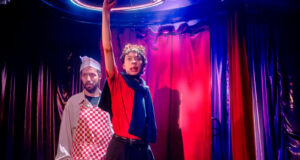Witty, moving and relatable, this one woman show tackles big issues in an accessible way and builds, literally, to a surprising conclusion.Summary
Rating
Excellent
There never seems to be enough time in the day to do everything I want to do. No matter how carefully I use my time, I still feel that my life is slipping by and the things I want to do never get any closer. It appears I have this nagging sensation in common with Miranda Prag, as it is the theme of the opening monologue of her one woman show, An Attempt to Lose Time. The monologue details a hectic day in her life and her worries that time is escaping her. I instantly connected with Prag (or the fictionalised version of her on stage): here was someone expressing what I have felt.
The show follows her attempt at a solution. Instead of trying to be more productive, she tries to lose her perception of time entirely. Prag ignores clocks, takes the timers off her phone and endeavours to find a different way to structure her life. In the middle of this experiment, the pandemic strikes and, to escape London, she takes her canal boat north on an adventure.
Prag’s narration of this story alternates with monologues about huge topics such as climate change, the fate of humanity, quantum physics, industrialisation and natural history. The seriousness of these issues is offset with references to mundane everyday life, from hand blenders to scrambled eggs, which provides levity and prevents the show becoming disconnected from our human experiences.
The superb writing is the production’s greatest strength. The script moves seamlessly from funny to moving, and from the particular to the universal. It is smart, witty and thought-provoking, whilst being accessible and relatable. The writing is clearly well researched and finely crafted.
Prag delivers a strong performance, which matches the tonal shifts of her script. I hung on every word she said in both sections performed live to the audience and in pre-recorded monologues, which are played as she deconstructs and then reconstructs a series of metal bars, bicycle wheels, and coloured discs, moving them from one seemingly abstract sculpture to another.
The minimal staging and costuming focuses the audience’s attention on the performance, the great writing and the physical act of rebuilding the abstract sculptures. This activity gives a sense of time passing, as the structures that appear on stage at the play’s opening are broken down and new ones built up to take their place. The structure of the story, Prag’s journey north, ending at the island of Unst, also gives the sense of temporal change. I enjoyed the irony of a show about escaping time being inevitably structured around it passing.
The crowning achievement here is the revelation that these are not purely abstract sculptures Prag is constructing. Once fully assembled, the new staging is able to move independently, providing a surprising conclusion. The abstract becomes definite, which mirrors the way that time, an abstract concept, has a definite hold on our lives.
I left the theatre with no notion of how much standard time had passed, as I was so engrossed in the show. Now I’m trying to pay less attention to clocks and to see if I too can lose time. If only for a short while.
Created and performed by: Miranda Prag
Produced by: Veronika Diamond
Supporting director: Anoushka Bonwick
Movement director: William Lang
An Attempt to Lose Time has completed its current run at Camden People’s Theatre
 Everything Theatre Reviews, interviews and news for theatre lovers, London and beyond
Everything Theatre Reviews, interviews and news for theatre lovers, London and beyond



